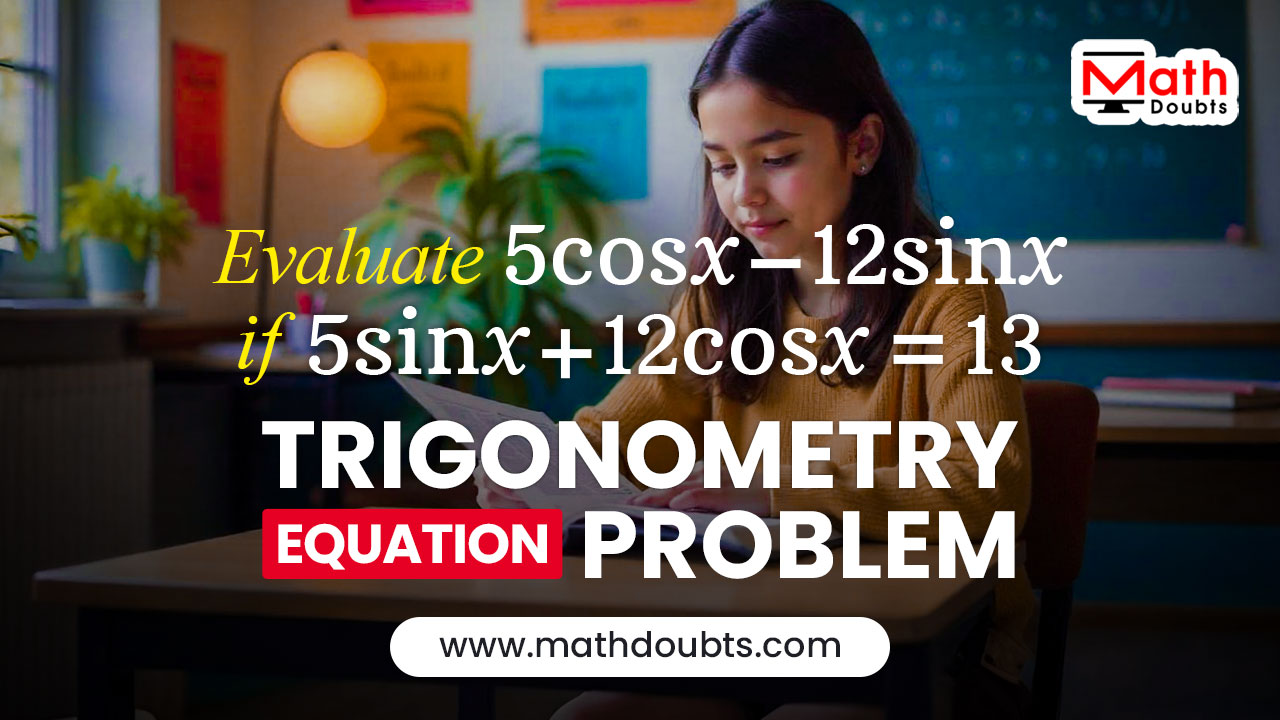Evaluate $5\cos{x}$ $-$ $12\sin{x}$, if $5\sin{x}$ $+$ $12\cos{x}$ $=$ $13$
The $5$ times sine of angle $x$ plus $12$ times cosine of angle $x$ is equal to $13$, is the given trigonometric equation in this trigonometry problem.
$5\sin{x}$ $+$ $12\cos{x}$ $=$ $13$
Now, we should have to find the value of a trigonometric expression $5$ times cosine of angle $x$ minus $12$ times sine of angles $x$ by using the given trigonometric equation.
$5\cos{x}$ $-$ $12\sin{x}$ $=$ $?$

Analyzing the given Trigonometric statements
The given two mathematical statements are defined in terms of sine and cosine as follows.
- $5\sin{x}$ $+$ $12\cos{x}$ $=$ $13$
- $5\cos{x}$ $-$ $12\sin{x}$
Now, compare the terms on the left-hand side of the trigonometric equation with the terms in the trigonometric expression to get an idea of finding the value of trigonometric expression.
The number $5$ is a common factor in the first terms of both expressions. Similarly, the number $12$ is a common factor in the second terms of both expressions.
The first mathematical statement is an equation. The second math statement is an expression and we should find its value. So, let’s denote its value by a variable $y$.
- $5\sin{x}$ $+$ $12\cos{x}$ $=$ $13$
- $5\cos{x}$ $-$ $12\sin{x}$ $=$ $y$
Now, we have two trigonometric equations and we have to find the value of $y$ by solving them.
Trick to eliminate the Trigonometric functions
The coefficients of $5$ are $\sin{x}$ and $\cos{x}$ in first terms, the coefficients of $12$ are also $\sin{x}$ and $\cos{x}$ in second terms on left-hand side of both equations. According to Pythagorean Identity of sine and cosine, the sum of squares of sine and cosine is equal to one. So, let’s square both sides of each equation.
- $(5\sin{x}$ $+$ $12\cos{x})^2$ $=$ $13^2$
- $(5\cos{x}$ $-$ $12\sin{x})^2$ $=$ $y^2$
Now, let’s add the above two equations to solve it by eliminating the functions sine and cosine.
$\implies$ $(5\sin{x}$ $+$ $12\cos{x})^2$ $+$ $(5\cos{x}$ $-$ $12\sin{x})^2$ $\,=\,$ $13^2$ $+$ $y^2$
Solve the Equation to evaluate Trigonometric expression
On the left side of the equation, the first term expresses the square of sum of two expressions and the second term denotes the square of difference between two expressions, whereas they can be expanded by the square of sum and square of difference algebraic identities.
- $(a+b)^2$ $=$ $a^2+2ab+b^2$
- $(a-b)^2$ $=$ $a^2-2ab+b^2$
Let’s use the above two algebraic identities to expand the squared expressions on the left-hand side of the equation.
$\implies$ $(5\sin{x})^2$ $+$ $2 \times 5\sin{x} \times 12\cos{x}$ $+$ $(12\cos{x})^2$ $+$ $(5\cos{x})^2$ $-$ $2 \times 5\cos{x} \times 12\sin{x}$ $+$ $(12\sin{x})^2$ $\,=\,$ $169$ $+$ $y^2$
Now, let’s simplify the trigonometric equation to find the value of $y$ mathematically.
$\implies$ $25\sin^2{x}$ $+$ $120\sin{x}\cos{x}$ $+$ $144\cos^2{x}$ $+$ $25\cos^2{x}$ $-$ $120\cos{x}\sin{x}$ $+$ $144\sin^2{x}$ $\,=\,$ $169$ $+$ $y^2$
Now, write the like terms closer in the trigonometric equation by using the commutative property.
$\implies$ $25\sin^2{x}$ $+$ $25\cos^2{x}$ $+$ $120\sin{x}\cos{x}$ $-$ $120\cos{x}\sin{x}$ $+$ $144\cos^2{x}$ $+$ $144\sin^2{x}$ $\,=\,$ $169$ $+$ $y^2$
$\implies$ $25\sin^2{x}$ $+$ $25\cos^2{x}$ $+$ $\cancel{120\sin{x}\cos{x}}$ $-$ $\cancel{120\sin{x}\cos{x}}$ $+$ $144\sin^2{x}$ $+$ $144\cos^2{x}$ $\,=\,$ $169$ $+$ $y^2$
Use the factorization method to take the common factor out from the terms.
$\implies$ $25 \times (\sin^2{x}$ $+$ $\cos^2{x})$ $+$ $144 \times (\sin^2{x}$ $+$ $\cos^2{x})$ $\,=\,$ $169$ $+$ $y^2$
According to Pythagorean trigonometric identity, the sum of squares of sine and cosine functions is equal to one.
$\implies$ $25 \times (1)$ $+$ $144 \times (1)$ $\,=\,$ $169$ $+$ $y^2$
The trigonometric equation becomes an algebraic equation and let’s solve the equation by simplifying it.
$\implies$ $25 \times 1$ $+$ $144 \times 1$ $\,=\,$ $169$ $+$ $y^2$
$\implies$ $25$ $+$ $144$ $\,=\,$ $169$ $+$ $y^2$
$\implies$ $169$ $\,=\,$ $169$ $+$ $y^2$
$\implies$ $169$ $+$ $y^2$ $\,=\,$ $169$
$\implies$ $y^2$ $\,=\,$ $169-169$
$\implies$ $y^2$ $\,=\,$ $0$
$\,\,\,\therefore\,\,\,\,\,\,$ $y$ $\,=\,$ $0$
Therefore, it is solved that the value of the variable $y$ is equal to zero.
Actually, there is no variable $y$ in the given trigonometry problem but we have taken it to denote the trigonometric expression. So, let’s replace the variable $y$ by its actual value.
$\implies$ $5\cos{x}$ $-$ $12\sin{x}$ $\,=\,$ $y$
$\,\,\,\therefore\,\,\,\,\,\,$ $5\cos{x}$ $-$ $12\sin{x}$ $=$ $0$
